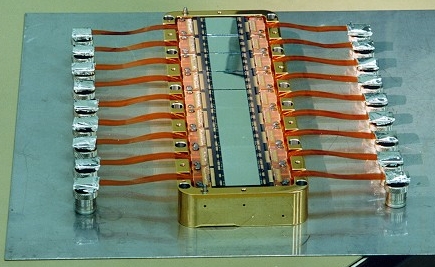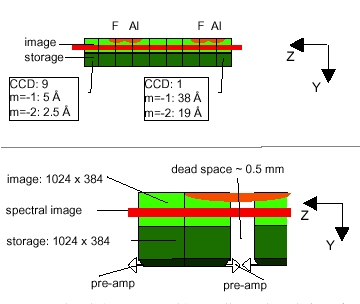Technical Details - RGS - XMM-Newton
The Reflection Grating Spectrometer (RGS) onboard XMM-Newton
This description is mostly based on the information contained in the papers
Brinkman, A. et al. 1998, in "Proceedings of the First XMM Workshop: Science with XMM", ESTEC, Noordwijk, The Netherlands, ed. M. Dahlem, and
den Herder, J. W. et al. 2001, A&A 365, L7
Further information can be obtained from the XMM-Newton Users' Handbook
Click for a list of RGS institutes.
Introduction
The X-ray Multi Mirror (XMM-Newton) mission is the second of the four cornerstone projects of the ESA long-term programme for space, Horizon 2000. The payload comprises three co-aligned high throughput telescopes with a FOV of 30 arcmin and spatial resolution of about 6 arcsec (FWHM). Imaging CCD detectors are placed in the focus of each telescope. Behind two of the three telescopes, about half of the X-ray light is utilized by the Reflection Grating Spectrometers (RGS). Each RGS consists of an array of reflection gratings which diffracts the X-rays to an array of dedicated charge coupled devices (CCD) detectors. The RGS instruments achieve high resolving power (150 to 800) over a range from 5 to 35 Å [0.33 to 2.5 keV] (in the first spectral order). The effective area peaks around 15 Å [0.83 keV] (first order) at about 150 cm2 for the two spectrometers.
Instrument Design
The RGS design incorporates an array of reflection gratings placed in the converging beam at the exit from the X-ray telescope. The grating stack intercepts roughly half of the X-ray light and deflects it to a strip of CCD detectors offset from the telescope focal plane. The undeflected light passes through and is intercepted by EPIC-MOS in the telescope focal plane. Nine large format back-illuminated CCDs are operated in single photon counting and frame transfer mode at a temperature of -80 C. For each photon, the position and the energy is measured: the position to determine the high resolution X-ray spectrum as diffracted by the grating module, and the energy and position to separate the contributions from the various overlapping grating orders (and from the in-flight calibration source) and to reduce the background.
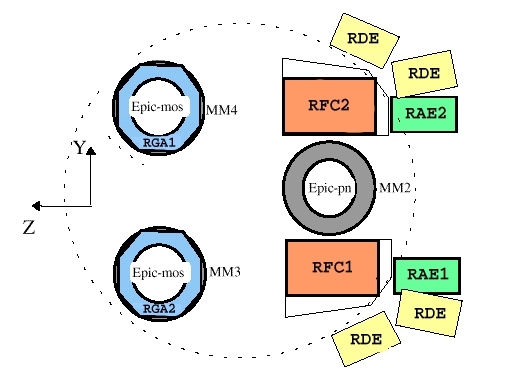 Relative position of various units. |
The instrument consists of two identical chains with the following units:
|
|
The grating stack consists of 182 identical gratings, mounted at grazing incidence to the beam in the classical configuration. The gratings are located in a toroidal surface, formed by rotating the Rowland circle about an axis passing through the telescope focus and the first order blaze focus. The dispersion equation for the spectrometer is given by: m lambda = d (cos beta - cos alpha )where "m" is the spectral order (-1, -2, ...), d is the groove spacing, "beta" is the angle between the outgoing ray and the grating plane, and "alpha" is the angle between the incoming ray and the grating plane referred to above. The gratings are fabricated to have "blazed" groove profiles, where the facets are all tilted with respect to the grating plane. With this orientation, the light is primarily diffracted into the "inside" spectral orders, where "m" < 0, so that "beta" > "alpha". The diffraction efficiency is maximized when the incident and exit angles on the facets are equal. Because the outgoing rays reflect at larger angles than the incoming rays, neighbouring gratings within the array vignet part of the diffracted light. The separation between the gratings was chosen to be as close as possible without vignetting the blaze wavelength. This implies that only a fraction of the light exiting the telescope is intercepted by the Reflection Grating Array. With the criterion above, this fraction is given approximately by sin(alpha)/sin(betablaze) = 0.53 (ignoring obstruction by structural elements). |
||||||||||||||||||||||||
 Schematic layout of the RGS (from Brinkman et al. 1998) |
Reflection Grating Array (RGA)
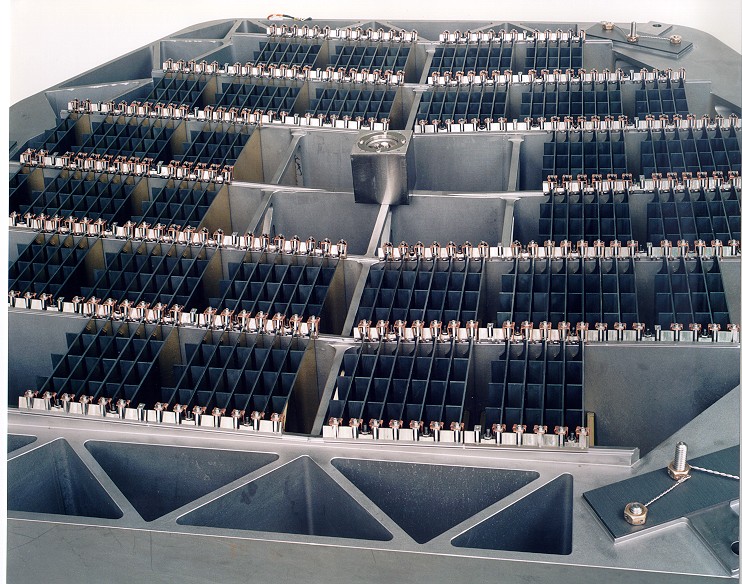
Detailed view of one of the RGAs
Each Reflection Grating Array contains 182 identical diffraction gratings (actually, one of the two RGAs contains 181 gratings due a problem found during installation), each measuring about 10x20 cm. The gratings are mounted in the classical configuration, in which the incident and diffracted rays lie in a plane which is perpendicular to the grating grooves. Because the beam is converging, the gratings are not parallel, and they are oriented so that the graze angle of the incident ray which intercepts the centre of the grating, "a", is the same for all gratings in the array. The telescope aperture is filled by rotating the Rowland circle about an axis passing through the telescope focus and the first order blaze focus. At any given position the grating grooves are nearly perpendicular to this plane. So as to make the array contiguous, the gratings are therefore slightly trapezoidal with their long edges parallel to the local converging light. In addition, the groove density on the gratings is not constant across the grating surface, varying by approximately ±10%. This is because the incident beam is converging, and aberrations would result if the line density were fixed. The groove density is approximately 646 grooves/mm at the centre.
The large grating substrates are very thin in order to keep the obstruction of the beam by the grating edges within reasonable limits. Early in the programme Beryllium was selected as the substrate material because of strength and mass considerations. However, it turned out to be very difficult to make Be-substrates with the required flatness tolerance, and SiC is the actual substrate material. The substrates are 1 mm thick with five stiffening ribs at the back running in the direction of the X-ray beam in order to maintain the required shape. The face sheets were fabricated to 1 wave (634.8 nm) and 10 waves flatness in the long and short direction, respectively.
The gratings were replicated from an identical set of master gratings onto the thin substrates. Master gratings produced by both mechanical ruling and by holographic means were tested and evaluated in this programme. Although holographic masters have been produced with somewhat higher reflection efficiency and lower scattering than mechanically ruled masters, unfortunately no suitable variable line density holographic master was available at the time of the flight model production. The gratings were covered with a 2000 Å gold coating.
The grating array support structure was machined out of a monolithic billet of vacuum hot-pressed Beryllium. Due to the importance of minimizing residual stress in the grating support structure, electrical discharge machining (spark erosion) was used in the initial machining process.
The precision alignment of the grating array was achieved by positioning the individual gratings against four, coplanar bosses which were precision-machined into stainless steel alignment rails mounted to the beryllium support structure. The gratings were held in this position by sets of spring chips. Alignment of the rails was achieved by interferometrically measuring the orientation and flatness of the first grating inserted for each set of rails. The array is supported from an attachment ring at the mirror assembly by three kinematic, titanium flexures.
The Reflection Grating Arrays were produced by Columbia University
Focal Plane Camera (RFC)
| The diffracted X-rays are detected with a strip of CCD detectors. The separation of spectral orders is accomplished by using the energy resolution of the CCDs. In addition this energy resolution provides the means for background suppression since it is required that events have the correct pulse height, corresponding to their spatial position in the spectrum. Thermal requirements were an important driver for the design of the focal plane camera. Three thermal nested shells constitute the interior of the camera; the CCD bench, heatshield 1 and heatshield 2. The CCD bench contains nine back-illuminated CCDs mounted in a row, following the curvature along the Rowland circle. The bottom of the CCD bench interfaces to a cold finger which provides the necessary cooling and ensures a uniform temperature of the bench on which the CCDs are mounted. A second, outer heatshield serves mainly for thermal purposes and was therefore made of thinner aluminum. An un-interrupted heat flow between the heatsink, i.e. radiator, on one end and the CCD bench on the other was necessary in order to avoid substantial temperature drops over this path and thus to arrive at the lowest envisaged temperatures on the CCD bench. This configuration allows the CCDs to be operated as low as -120 C, whereas the normal operating temperature is -80 C. |
|
The first shield also contains four internal calibration sources. These consist of the alpha-emitter 244Cm, and an Al target or a Teflon target, which produces Al K alpha (1487 eV) and F K alpha (676.8 eV) fluorescent emission. These sources each illuminate a small area of two CCDs, which is offset in the cross dispersion direction from the source image. The use of the sources is twofold, not only it allow energy gain monitoring, but also monitoring of the efficiency variation with time. The latter is particularly important since condensable materials will accumulate on the cold detector surface. If too much contamination build-up takes place, e.g. ice in the early phases of the mission or possibly worse, hydrocarbons, the CCD bench can be heated-up, to boil-off contaminants.
The detector is configured as a strip detector along the Rowland circle with a radius of 335 cm. In order to cover the 5-35 Å range, a length of 253 mm was required. The nine CCD-chips are back-illuminated GEC/EEV devices with two 384 by 1024 pixels, of 27x27 µm2 each. The width of the detector was matched to the height of the RGS spectrum (2.2 mm for 90 % energy width) and to the spacecraft absolute pointing error.
| For optimum scientific performance, the detector is operated in the so-called frame transfer mode: the image is first accumulated in one half of the CCD (image section) and then quickly (20 msec) transferred to the other half (storage section) prior to read-out through two low noise on-chip amplifiers. This doubles the read out speed and gives redundancy in case of an amplifier failure. Diffusion of the primary electron cloud, during its transport from the X-ray absorption position to the bottom of the potential well, generates split events, i.e. events in which the charge created by one X-ray photon is spread out over two or more pixels. Without additional split event processing, either on board or on the ground, the existence of split events would give rise to efficiency loss at the low energy side of the spectrometer, degraded energy resolution and an increased background due to the need for wider energy band thresholds. Split event handling can be performed in two different ways, by on-chip binning (OCB) and by split event processing. The resolution elements of the RGS (0.25x2.0 mm) are very much oversampled by the CCD pixelsize of 27 µm2. On-chip (noise free) binning of up to 3x3 pixels is possible without any penalty to the spectral resolution of the RGS and is therefore the baseline, resulting in a reduction of the read-out time and the read-out noise (as most X-rays will be confined to two 3x3 bins). Since CCDs have high efficiency for detection of optical light, a filter for the rejection of optical photons was included. This light shield was isolated from the Si by a MgF2 isolation layer (about 26 nm thick).The CCDs were covered with a layer of Al whose thickness depends on their position in the array. The Al shield is 75 nm thick for the two CCDs closest to the optical pre-amp, 68 nm for the next three CCDs, and 45 nm for the four CCDs furthest away from the optical axis. This gives a reduction in stray light between 105 and 102 , equivalent to 1 electron per pixel per readout. |
|
The CCDs were procured from EEV Ltd.
The front end electronics and the calibration of the CCDs were performed by SRON.
The detector housing were procured by the Paul Scherrer Institute.
Analogue electronics (RAE) and Digital electronics (RDE) Units
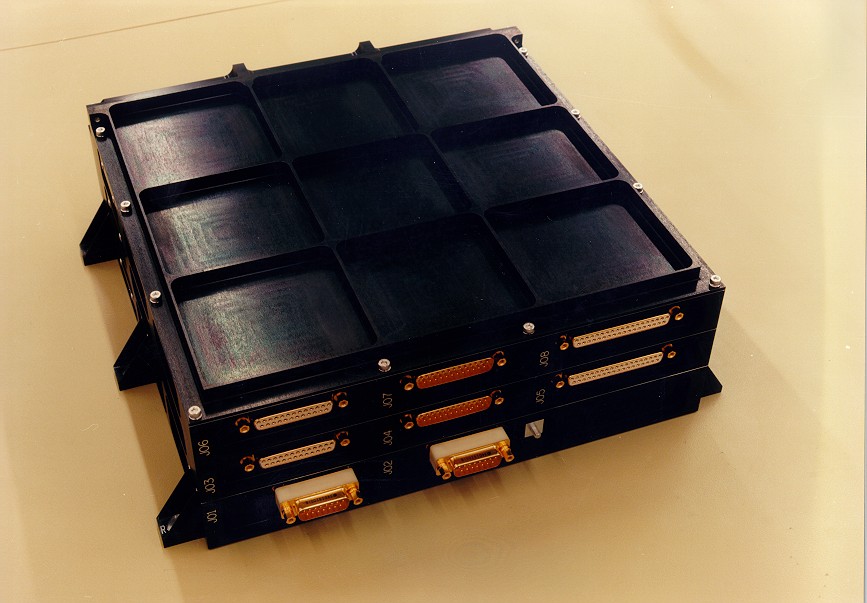 |
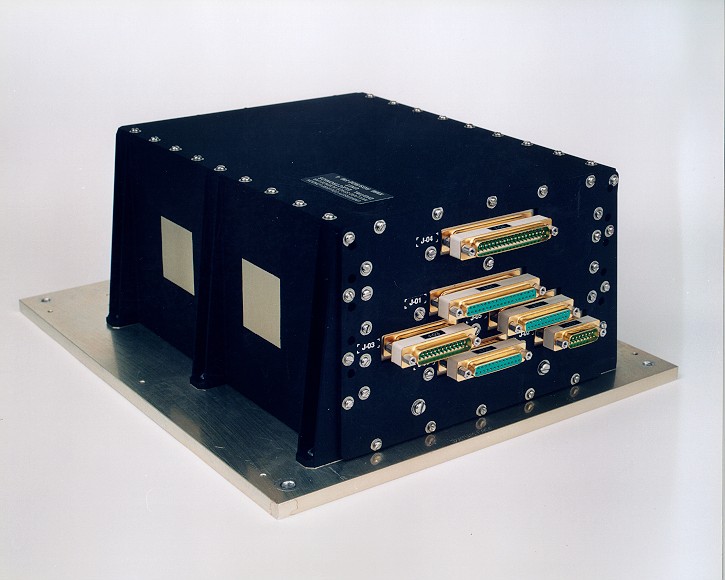 |
|
RAE
|
RDE
|
The front-end electronics (clock-drives and pre-amplifiers for the CCDs) is part of the detector. The instrument is under control of the Instrument Controller (IC, MA31750 processor) which is fully programmable. The IC sets all bias settings of the CCDs and also configures the Clock Sequence Generator (CSG) which controls the clock drivers for each CCD. Different clock patterns can be loaded from the ground. The nominal readout of each CCD is through two output nodes resulting in different gains and offsets per read-out node of each CCD. The signals are amplified close to the focal plane camera and digitized in the RAE using a correlated double sampler (CDS).
All data are then transferred to the Data Pre-Processor. The temperature of the CCD bench is controlled by the RDE and this unit includes also the power converter (Power Supply Unit). All interfaces with the spacecraft On Board Data Handling bus (OBDH) are channelled via the IC. During periods when RGS is switched off (immediately following launch and during eclipses) the spacecraft provides a fixed power level to the CCD bench to avoid too much cooling. The control chain is fully cold redundant (hence two RDEs) whereas the signal chain is warm redundant. In case of a failure in one of the two signal chains it is possible to read out the CCDs through one output node. In case of the failure of a single CCD the others will not be affected and the second camera would provide the required redundancy (although the effective area will then be reduced).
The RAE was produced at SRON, and the RDEs (2 per instrument) were produced at MSSL.
Back to the technical descriptions index.
- Removed a total of (4) style text-align:center;
- Removed a total of (1) align=top;
- Removed a total of (1) style float:left;
- Removed a total of (1) align=center.
- Removed a total of (5) border attribute.
- Removed a total of (8) cellpadding attribute.
- Removed a total of (7) cellspacing attribute.
- Converted a total of (5) center to div.








































 Sign in
Sign in
 Science & Technology
Science & Technology
